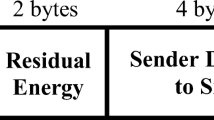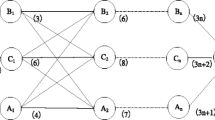Abstract
Development of efficient techniques for improving data transmission reliability is a major concern in the design of underwater acoustic sensor networks (UWASNs). In this paper, we propose an erasure code based multi-hop reliable data transfer scheme (ECRDT) for UWASNs. ECRDT is essentially a packet level forward error correction scheme based on either end-to-end erasure coding or hop-by-hop erasure coding. In the end-to-end approach, encoding and decoding are performed by the source node and sink node, respectively, while intermediate nodes just forward the data packets without any processing. The hop-by-hop erasure coding achieves per hop reliable data transfer along the multi-hop path. In this case, apart from the source node, all intermediate nodes perform encoding process and each node is required to adaptively compute the number of redundant packets for the next hop based on the quality of the corresponding hop. We present an analytical model to find the communication overhead, energy consumption and average delay of the multi-hop UWASN under the above erasure coding approaches. Simulation and analytical results show that the proposed ECRDT scheme based on hop-by-hop erasure coding can significantly reduce communication overhead, energy consumption and average delay.
















Similar content being viewed by others
References
Akyildiz, I. F., Pompili, D., & Melodia, T. (2005). Underwater acoustic sensor networks: Research challenges. Ad Hoc Networks, 3(3), 257–279.
Partan, J., Kurose, J., & Levine, B. N. (2007). A survey of practical issues in underwater networks. ACM SIGMOBILE Mobile Computing and Communications Review, 11(4), 23–33.
Heidemann, J., et al. (2006). Research challenges and applications for underwater sensor networking. In Wireless communications and networking conference, WCNC 2006 (Vol. 1, pp. 228–235). IEEE.
Pompili, D., & Akyildiz, I. F. (2009). Overview of networking protocols for underwater wireless communications. IEEE Communications Magazine, 47(1), 97–102.
Akyildiz, I. F., Pompili, D., & Melodia, T. (2006). State-of-the-art in protocol research for underwater acoustic sensor networks. In Proceedings of the 1st ACM international workshop on underwater networks (pp. 7–16). ACM.
Vuran, M. C., & Akyildiz, I. F. (2009). Error control in wireless sensor networks: A cross layer analysis. IEEE/ACM Transactions on Networking, 17(4), 1186–1199.
Rizzo, L. (1997). Effective erasure codes for reliable computer communication protocols. ACM SIGCOMM Computer Communication Review, 27(2), 24–36.
Gao, M., Soh, W. S., & Tao, M. (2009). A transmission scheme for continuous ARQ protocols over underwater acoustic channels. In IEEE international conference on communications (ICC’09) (pp. 1–5).
Lee, J. W., Cheon, J. Y., & Cho, H. S. (2010). A cooperative ARQ scheme in underwater acoustic sensor networks. In OCEANS 2010 IEEE-Sydney (pp. 1–5).
Lee, J. W., Kim, J. P., Lee, J. H., Jang, Y. S., Dho, K. C., Son, K., & Cho, H. S. (2008). An improved ARQ scheme in underwater acoustic sensor networks. In OCEANS 2008-MTS/IEEE Kobe Techno-Ocean (pp. 1–5).
Zhuang, H., Tan, H. P., Valera, A., & Bai, Z. (2009). Opportunistic ARQ with bidirectional overhearing for reliable multihop underwater networking. In OCEANS 2010 IEEE-Sydney (pp. 1–6).
Stojanovic, M. (2005). Optimization of a data link protocol for an underwater acoustic channel. In Oceans 2005-Europe (Vol. 1, pp. 68–73). IEEE
Xie, P., & Cui, J.-H. (2007). An FEC-based reliable data transport protocol for underwater sensor networks. In Proceedings of 16th international conference on computer communications and networks, ICCCN 2007 (pp.747–753). IEEE.
Xie, P., Zhou, Z., Peng, Z., Cui, J. H., & Shi, Z. (2010). SDRT: A reliable data transport protocol for underwater sensor networks. Ad Hoc Networks, 8(7), 708–722.
Zhou, Z., Mo, H., Zhu, Y., Peng, Z., Huang, J., & Cui, J. H. (2012). Fountain code based adaptive multi-hop reliable data transfer for underwater acoustic networks. In IEEE international conference on communications (ICC) (pp. 6396–6400).
Lucani, D. E., Mdard, M., & Stojanovic, M. (2007). Network coding schemes for underwater networks: The benefits of implicit acknowledgment. In Proceedings of the second workshop on underwater networks (pp. 25-32). ACM.
Mo, H., et al. (2012). Practical coding-based multi-hop reliable data transfer for underwater acoustic networks. In Global communications conference (GLOBECOM) (pp. 5751–5756). IEEE.
Mo, H., et al. (2013). Coding based multi-hop coordinated reliable data transfer for underwater acoustic networks: Design, implementation and tests. In Global communications conference (GLOBECOM) (pp. 4566–4571). IEEE.
Guo, Z., et al. (2009). Efficient error recovery with network coding in underwater sensor networks. Ad Hoc Networks, 7(4), 791–802.
Xie, P., Cui, J.-H., & Lao, L., (2006). VBF: Vector-based forwarding protocol for underwater sensor networks. In Networking 2006. Networking technologies, services, and protocols; performance of computer and communication networks; mobile and wireless communications systems (pp. 1216–1221). Berlin: Springer.
Cai, S., et al. (2013). A network coding based protocol for reliable data transfer in underwater acoustic sensor. Ad Hoc Networks, 11(5), 1603–1609.
Cai, S., Yao, N., & Gao, Z. (2015). A reliable data transfer protocol based on twin paths and network coding for underwater acoustic sensor network. EURASIP Journal on Wireless Communications and Networking, 2015(1), 1–6.
Liu, B., et al. (2008). A study of forward error correction schemes for reliable transport in underwater sensor networks. In SECON’08. 5th annual IEEE communications society conference on sensor, mesh and ad hoc communications and networks, 2008 (pp. 197–205), IEEE.
Liu, B., Chen, H., Lei, X., Ren, F., & Sezaki, K. (2010). Internode distance-based redundancy reliable transport in underwater sensor networks. EURASIP Journal on Wireless Communications and Networking, 2, 1–16.
Zhou, Z., & Cui, J.-H. (2008). Energy efficient multi-path communication for time-critical applications in underwater sensor networks. In Proceedings of the 9th ACM international symposium on mobile ad hoc networking and computing (pp. 221–230). ACM.
Xu, J., Li, K., & Min, G. (2012). Reliable and energy-efficient multipath communications in underwater sensor networks. IEEE Transactions on Parallel and Distributed Systems, 23(7), 1326–1335.
Sun, N., Han, G., Wu, T., Jiang, J., & Shu, L. (2015). A reliable and energy efficient VBF-improved cross-layer protocol for underwater acoustic sensor network. In 2015 11th international conference on heterogeneous networking for quality, reliability, security and robustness (QSHINE) (pp. 44–49). IEEE.
Nowsheen, N., Karmakar, G., & Kamruzzaman, J. (2014). An adaptive approach to opportunistic data forwarding in underwater acoustic sensor networks. In 2014 IEEE 13th international symposium on network computing and applications (NCA) (pp. 229–236). IEEE.
Chen, B., & Pompili, D. (2014). Reliable geocasting for random-access underwater acoustic sensor networks. Ad Hoc Networks, 21, 134–146.
Hao, K., et al. (2015). An efficient and reliable geographic routing protocol based on partial network coding for underwater sensor networks. Sensors, 15(6), 12720–12735.
Dulman, S., et al. (2003). Trade-off between traffic overhead and reliability in multipath routing for wireless sensor networks (Vol. 3, pp. 1918–1922). IEEE.
Wen, H., et al. (2007). Retransmission or redundancy: Transmission reliability in wireless sensor networks. In IEEE internatonal conference on mobile ad hoc and sensor systems, 2007. MASS 2007 (pp. 1–7).
Kim, S., Fonseca, R., & Culler, D. (2004). Reliable transfer on wireless sensor networks. In First annual IEEE communications society conference on sensor and ad hoc communications and networks, IEEE SECON 2004 (pp. 449–459).
Mutschlechner, M., et al. (2014). Using erasure codes to overcome reliability issues in energy-constrained sensor networks. In 2014 11th annual conference on wireless on-demand network systems and services (WONS) (pp. 41–48). IEEE
Kim, S. (2004). Efficient erasure code for wireless sensor networks. Available from: visited in Nov of 2008. http://www.cs.berkeley.edu.
Luby, M. G., Mitzenmacher, M., Shokrollahi, M. A., & Spielman, D. A. (2001). Efficient erasure correcting codes. IEEE Transactions on Information Theory, 47(2), 569–584.
Reed, I. S., & Solomon, G. (1960). Polynomial codes over certain finite fields. Journal of the Society for Industrial and Applied Mathematics, 8(2), 300–304.
Luby, M. (1998). Tornado codes: Practical erasure codes based on random irregular graphs. In Randomization and approximation techniques in computer science (pp. 171–171). Berlin: Springer.
Luby, M. (2002). LT codes. In 2013 IEEE 54th annual symposium on foundations of computer science (pp. 271–271). IEEE Computer Society.
Shokrollahi, A. (2006). Raptor codes. IEEE Transactions on Information Theory, 52(6), 2551–2567.
Medwin, H., & Blue, J. E. (2005). Sounds in the sea: From ocean acoustics to acoustical oceanography. Cambridge: Cambridge University Press.
Goldsmith, A. (2005). Wireless communications. Cambridge: Cambridge University Press.
Urick, R. J. (1967). Principles of underwater sound for engineers. New York: Tata McGraw-Hill Education.
Domingo, M. C., & Prior, R. (2008). Energy analysis of routing protocols for underwater wireless sensor networks. Computer Communications, 31(6), 1227–1238.
Thorp, W. H. (1967). Analytic description of the low frequency attenuation coefficient. The Journal of the Acoustical Society of America, 42(1), 270–270.
Yan, H., Shi, Z. J., & Cui, J. H. (2008). DBR: Depth-based routing for underwater sensor networks. In NETWORKING 2008 ad hoc and sensor networks, wireless networks, next generation internet (pp. 72–86). Berlin: Springer.
Xie, P., et al. (2009). Aqua-sim: An NS-2 based simulator for underwater sensor networks. In OCEANS 2009, MTS/IEEE biloxi-marine technology for our future: global and local challenges (pp. 1–7). IEEE.
Author information
Authors and Affiliations
Corresponding author
Rights and permissions
About this article
Cite this article
Geethu, K.S., Babu, A.V. Erasure Codes Based Adaptive Multi-hop Reliable Data Transfer for Underwater Acoustic Sensor Networks. Wireless Pers Commun 94, 579–604 (2017). https://doi.org/10.1007/s11277-016-3638-5
Published:
Issue Date:
DOI: https://doi.org/10.1007/s11277-016-3638-5




